Edible Flowers
Some people find the concept of eating flowers to be a little strange - indeed there are a few who find the very idea to be distasteful. This is rather sad because, as well as providing a nutritious food, there are some amazing taste treats in store for those who are willing to experiment with their foods. Nutritionally, the flower can be divided into three main elements. Firstly, there is the pollen. Although only present in fairly small quantities, this is a very rich source of protein and so helps to build and maintain the body structure. Its flavour is usually rather bland. Secondly, we have the nectar. This is usually rather sweet and is the substance that most attracts bees to the flowers to pollinate them. The bees turn the nectar into honey - when we eat the flowers we can use the sugars in the nectar to provide us with a good source of energy. Nectar provides a balanced form of sugars together with a range of minerals and does not have the negative effects of refined sugars, such as rotting the teeth. Finally, we have the petals and other parts of the flower structure. Although not normally as nutritious as leaves, they do have many similarities nutritionally and so can provide us with a good range of vitamins and minerals. Yellow flowers, in particular, are very good sources of vitamin A.
The flavour and texture of flowers varies from species to species. Some are very crisp and crunchy, others almost silky soft. A few flowers have a very savoury taste whilst others can be very hot or have a very mild flavour. Depending on the quantities of nectar present, they can also be very sweet. If looking primarily for sweetness, by the way, you will normally be best off picking the flowers in the morning before bees and other insects have depleted the stocks of nectar.
Flowers can make a very attractive addition to salads, the only problem can be that they make a salad so attractive that people are reluctant to disturb what they see as a work of art! Flowers can also provide a tasty and thirst-quenching snack when working in the garden. In every case they are probably only suitable for eating raw, as they are so delicate that both their texture and taste would be destroyed by cooking. Unless stated otherwise, all the plants listed below are herbaceous perennials and should be hardy in most parts of the country. They are quite a diverse range of plants, and species suitable for almost any niche in the garden will be found here. It is therefore very difficult to give general notes on their cultivation needs, though a very brief guide will be given.

 Allium species. The flowers of the various ONIONS and GARLICS have a very similar taste to the leaves, though they are usually somewhat stronger and also sweeter. They make a particularly attractive addition to salads. By careful selection of species, it is possible to have flowers from spring to early winter. Please see the pfaf.org website for ‘Allium species -the Perennial Onions’, which deals with this genus in much greater detail than can be covered here. Unless stated otherwise, all members of this genus require a well-drained soil and a sunny position. In general they do not grow well with weed competition, though there are exceptions.
Allium species. The flowers of the various ONIONS and GARLICS have a very similar taste to the leaves, though they are usually somewhat stronger and also sweeter. They make a particularly attractive addition to salads. By careful selection of species, it is possible to have flowers from spring to early winter. Please see the pfaf.org website for ‘Allium species -the Perennial Onions’, which deals with this genus in much greater detail than can be covered here. Unless stated otherwise, all members of this genus require a well-drained soil and a sunny position. In general they do not grow well with weed competition, though there are exceptions.
A. cernuum. The NODDING ONION grows about 40cm tall, forming a clump about 25cm wide, it has some of the most beautiful flowers in the genus. These are produced in mid summer and have a strong onion flavour. If you can obtain it, the cultivar ‘Major’ is a more vigorous form with larger flower clusters.
A. moly. GOLDEN GARLIC grows up to 30cm tall and 10cm wide. Its yellow flowers are produced in early summer and have a very crisp texture with a garlic-like flavour. An excellent flavouring in salads, though too strong to be used in large quantities. Be careful not to get the sub-species A. moly bulbiferum since this produces bulbils in the flowering head and can be invasive. Golden garlic is a very vigorous plant that can look after itself, it is useful for naturalising between shrubs and grows well at the base of a beech hedge in a wet garden.
A. neapolitanum. Growing up to 30cm tall and 20cm wide, DAFFODIL GARLIC produces its white flowers in mid
spring. These have a delicious sweetness followed by a fairly strong garlic flavour. The plant is not hardy in the colder areas, but in gardens where it is happy it will usually self-sow quite freely. Try to obtain the cultivar ‘Grandiflorum’ since this has larger flowers which are also produced in greater abundance.
A. tuberosum. GARLIC CHIVES grows about 30cm tall and 25cm wide. Its white flowers, which are produced in the autumn, have a pleasant onion flavour.
A. ursinum. WILD GARLIC is a plant for naturalising in woodlands, where it can form extensive carpets of growth. The white flowers are produced in mid to late spring and have a strong garlic flavour.
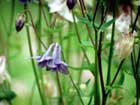 Aquilegia vulgaris. COLUMBINE is a very beautiful British native plant growing up to 1 metre tall and 50cm wide. Very easily grown, it succeeds in most soils and prefers a position in sun or light shade. When well sited it will usually self-sow freely. Although all other parts of the plant are mildly toxic, the flowers are perfectly safe to eat. Rich in nectar, they make a sweet and delightful addition to mixed salads. There are many named varieties and a whole range of different colours can be grown. All other members of this genus can be used in similar ways.
Aquilegia vulgaris. COLUMBINE is a very beautiful British native plant growing up to 1 metre tall and 50cm wide. Very easily grown, it succeeds in most soils and prefers a position in sun or light shade. When well sited it will usually self-sow freely. Although all other parts of the plant are mildly toxic, the flowers are perfectly safe to eat. Rich in nectar, they make a sweet and delightful addition to mixed salads. There are many named varieties and a whole range of different colours can be grown. All other members of this genus can be used in similar ways.
 Asclepias tuberosa. Growing up to 75cm tall and 50cm wide, PLEURISY ROOT prefers a well-drained light, rich or peaty soil that is on the dry side, and a sunny position. The plants are particularly attractive to slugs and some protection will probably be required, especially in the spring when the new shoots come into growth. The beautiful orange flowers are produced in mid to late summer. In hot weather they produce so much nectar that this crystallises out into small lumps which can then be eaten like sweets. The flower clusters can also be boiled down to make a sugary syrup. For more information about the many uses of this plant and other members of the genus, please see the pfaf.org website for ‘The Milkweeds’.
Asclepias tuberosa. Growing up to 75cm tall and 50cm wide, PLEURISY ROOT prefers a well-drained light, rich or peaty soil that is on the dry side, and a sunny position. The plants are particularly attractive to slugs and some protection will probably be required, especially in the spring when the new shoots come into growth. The beautiful orange flowers are produced in mid to late summer. In hot weather they produce so much nectar that this crystallises out into small lumps which can then be eaten like sweets. The flower clusters can also be boiled down to make a sugary syrup. For more information about the many uses of this plant and other members of the genus, please see the pfaf.org website for ‘The Milkweeds’.
 Asphodeline lutea. Growing up to 1 metre tall and eventually forming a clump 1 metre or more wide, YELLOW ASPHODEL is a very easily grown plant that succeeds in most soils so long as they are well drained. It grows best in full sun, though it also tolerates partial shade and is very drought tolerant. The yellow star-shaped flowers are an epicurean’s treat. They have a delightful sweetness and are delicious either on their own or in salads. They do need to be used as soon as possible after harvesting, however, because they do not store and will soon start to decompose. The plant flowers from late spring until the middle of summer -individual flowers are very short-lived, but new flowers are produced every day. If you pick them in the evening you can enjoy them visually during the day and gastronomically in the evening.
Asphodeline lutea. Growing up to 1 metre tall and eventually forming a clump 1 metre or more wide, YELLOW ASPHODEL is a very easily grown plant that succeeds in most soils so long as they are well drained. It grows best in full sun, though it also tolerates partial shade and is very drought tolerant. The yellow star-shaped flowers are an epicurean’s treat. They have a delightful sweetness and are delicious either on their own or in salads. They do need to be used as soon as possible after harvesting, however, because they do not store and will soon start to decompose. The plant flowers from late spring until the middle of summer -individual flowers are very short-lived, but new flowers are produced every day. If you pick them in the evening you can enjoy them visually during the day and gastronomically in the evening.
.jpg) Campanula species. This is a very large genus that contains some very desirable ornamental plants. They are in general fairly easy to grow, most of them preferring a position in full sun and all of them requiring a well-drained soil. They are little bothered by pests and diseases, though slugs adore the leaves and can totally decimate the plants in wet weather. All members of this genus have more or less edible flowers; these are usually bell-shaped and come in some shade of blue, though whites can often also be found. They usually have a mild flavour with a delicate sweetness. Only two favourites are mentioned here, though feel free to try any other species you might be growing since none of them are poisonous.
Campanula species. This is a very large genus that contains some very desirable ornamental plants. They are in general fairly easy to grow, most of them preferring a position in full sun and all of them requiring a well-drained soil. They are little bothered by pests and diseases, though slugs adore the leaves and can totally decimate the plants in wet weather. All members of this genus have more or less edible flowers; these are usually bell-shaped and come in some shade of blue, though whites can often also be found. They usually have a mild flavour with a delicate sweetness. Only two favourites are mentioned here, though feel free to try any other species you might be growing since none of them are poisonous.
C. persicifolia. This species grows about 1 metre tall, spreading quite quickly at the roots to form large clumps. It succeeds in light shade or full sun, growing well on a woodland edge. The flowers are produced from early to mid summer.
C. versicolor. Growing up to 1.2 metres tall and 50cm wide, the beautiful flowers are produced in abundance from mid summer, until the autumn frosts finally convince the plant that no more seed will be ripened this year. The plant requires a warm, sheltered position and is not hardy in the colder areas.
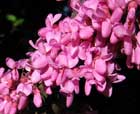 Cercis siliquastrum. The JUDAS TREE is a deciduous tree growing up to 12 metres tall and 10 metres wide, though it is usually somewhat smaller in temperate regions. It succeeds in most soils, including chalk and dry sands, though it dislikes growing in wet soils, especially when these are of clay. A nitrogen-fixing plant, it flowers better, and is somewhat hardier, when growing on a poorish soil. It requires a very warm sunny position if it is to flower well. The purple pea-like flowers are produced on the branches of the previous or earlier years, and also on the trunk of the plant. They have a sweetish-acid taste and are a nice addition to the salad bowl.
Cercis siliquastrum. The JUDAS TREE is a deciduous tree growing up to 12 metres tall and 10 metres wide, though it is usually somewhat smaller in temperate regions. It succeeds in most soils, including chalk and dry sands, though it dislikes growing in wet soils, especially when these are of clay. A nitrogen-fixing plant, it flowers better, and is somewhat hardier, when growing on a poorish soil. It requires a very warm sunny position if it is to flower well. The purple pea-like flowers are produced on the branches of the previous or earlier years, and also on the trunk of the plant. They have a sweetish-acid taste and are a nice addition to the salad bowl.
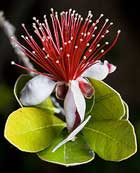 Feijoa sellowiana. The FEIJOA is an evergreen shrub growing up to 3 metres tall and wide, though it can be kept smaller by trimming. It is not very cold hardy and needs the protection of a sunny south or west-facing wall in all but the mildest areas. It prefers a light loamy well-drained soil and can tolerate drought and salt winds. The flower petals are thick and crunchy with a sweet, crisp and delicious flavour, indeed they taste more like a fruit than many fruits.
Feijoa sellowiana. The FEIJOA is an evergreen shrub growing up to 3 metres tall and wide, though it can be kept smaller by trimming. It is not very cold hardy and needs the protection of a sunny south or west-facing wall in all but the mildest areas. It prefers a light loamy well-drained soil and can tolerate drought and salt winds. The flower petals are thick and crunchy with a sweet, crisp and delicious flavour, indeed they taste more like a fruit than many fruits.

.jpg)
.jpg)
Hemerocallis species. DAYLILIES are commonly grown ornamental plants. Easily cultivated, they grow well in most soils, though they do best in rich moist conditions and succeed in sun or shade. They are very tolerant of neglect and will succeed in short grass if the soil is moist. The only real difficulty in growing the plants is that slugs really adore the young growth and can cause considerable damage to newly planted plants or the young growth in spring. All members of this genus have edible flowers. These are trumpet-shaped, vary in size from 5 - 20cm. and look like lilies. In most of the species these flowers only live for one day, hence the common name. The petals are crisp and juicy with a mild sweet flavour - the base of the flower is particularly sweet due to the nectar contained there - and they make an excellent munch in the garden or can be used to decorate salads. In China the flowers are harvested as they begin to wither and are then dried and used as a flavouring and thickener in cooked foods. The following species are amongst our favourites, though it is also worthwhile trying any of the many cultivars that are grown. The only word of warning is that if the flowers are bright yellow or scented then they can often have an unpleasant aftertaste. For more information on this genus please see the pfaf.org website for ‘Hemerocallis Species - The Day Lilies’.
H. dumortieri. The plants grow about 45cm tall and form a tight slowly-spreading clump 60cm or more wide. They flower from late spring to early summer.
H. fulva. If you are only going to grow one daylily, then this is the species to go for. A vigorous spreading plant, it grows up to 1 metre tall and 1 metre or more wide. The flowers can be up to 20cm long, they have particularly thick, crunchy and tasty petals, whilst the taste is just amazing. They are produced in mid-summer. There are a number of double-flowered named cultivars of this species that are cultivated for their edible flowers in the Orient. With twice as many petals per flower, these are especially delicious to eat. Cultivars to look out for are ‘Kwanzo’, ‘Green Kwanzo’ and ‘Flore pleno’.
H. middendorffii esculenta grows about 50cm tall and wide, flowering in early to mid summer. The flowers are up to 10cm long and are another of the especially well flavoured ones.
H. multiflora. Growing up to 1 metre tall and forming a tight clump about 60cm or more wide, the flowers of this species are only about 5 - 8cm long but are produced in great profusion from mid to late summer.
.jpg) Hibiscus syriacus. A deciduous shrub growing up to 3 metres tall and 2 metres wide, though it can be kept smaller by trimming. It succeeds in any soil of good or moderate quality, though it prefers a well-drained humus rich fertile soil and a sheltered position in full sun. It dislikes deep shade or badly drained soils and grows best with its roots in cool moist soil and its tops in a hot sunny position. Although hardy to about -20°c, it flowers in the autumn and will only produce these flowers in profusion when growing in warmer temperate areas. The flowers are 5cm or more across and are stunningly beautiful - there are many named varieties providing a wide range of colours. The flavour is mild and they have a mucilaginous texture. They are delightful in salads, both for looking at and for eating.
Hibiscus syriacus. A deciduous shrub growing up to 3 metres tall and 2 metres wide, though it can be kept smaller by trimming. It succeeds in any soil of good or moderate quality, though it prefers a well-drained humus rich fertile soil and a sheltered position in full sun. It dislikes deep shade or badly drained soils and grows best with its roots in cool moist soil and its tops in a hot sunny position. Although hardy to about -20°c, it flowers in the autumn and will only produce these flowers in profusion when growing in warmer temperate areas. The flowers are 5cm or more across and are stunningly beautiful - there are many named varieties providing a wide range of colours. The flavour is mild and they have a mucilaginous texture. They are delightful in salads, both for looking at and for eating.
.jpg) Malva moschata. The MUSK MALLOW is another very easily grown plant, growing up to 80cm tall and 60cm wide. It succeeds in most soils, though it prefers a reasonably well-drained and moderately fertile soil in a sunny position. Individual plants are generally quite short-lived though they can self-sow freely when in a suitable position and usually more than maintain themselves. The flowers are produced in great abundance in mid summer - if the plants are cut back when they are finishing flowering then they will often produce a fresh flush in early spring. These flowers have a very mild flavour and mucilaginous texture; they make an excellent and very decorative addition to the salad bowl. M. alcea is a closely related plant that can be used in the same way.
Malva moschata. The MUSK MALLOW is another very easily grown plant, growing up to 80cm tall and 60cm wide. It succeeds in most soils, though it prefers a reasonably well-drained and moderately fertile soil in a sunny position. Individual plants are generally quite short-lived though they can self-sow freely when in a suitable position and usually more than maintain themselves. The flowers are produced in great abundance in mid summer - if the plants are cut back when they are finishing flowering then they will often produce a fresh flush in early spring. These flowers have a very mild flavour and mucilaginous texture; they make an excellent and very decorative addition to the salad bowl. M. alcea is a closely related plant that can be used in the same way.
.jpg) Oxalis deppei. The IRON CROSS PLANT is a dainty creature that grows up to 30cm tall and 10cm wide. An easily grown plant, it prefers a well-drained sandy soil in a warm dry position and strongly dislikes wet or heavy soils. It is only hardy outdoors in the milder areas, tolerating temperatures down to about -5°c, or perhaps a bit lower if the soil is very well-drained. The bulbs are easily harvested in late autumn, however, and can be stored overwinter in a cool frost free place, replanting them in the spring. In milder winter areas a good mulch is usually sufficient to see the bulbs through the winter and they will then normally be more productive of leaves and flowers in the following year. The flowers are produced from early or mid-summer until growth is killed back by autumn frosts.
Oxalis deppei. The IRON CROSS PLANT is a dainty creature that grows up to 30cm tall and 10cm wide. An easily grown plant, it prefers a well-drained sandy soil in a warm dry position and strongly dislikes wet or heavy soils. It is only hardy outdoors in the milder areas, tolerating temperatures down to about -5°c, or perhaps a bit lower if the soil is very well-drained. The bulbs are easily harvested in late autumn, however, and can be stored overwinter in a cool frost free place, replanting them in the spring. In milder winter areas a good mulch is usually sufficient to see the bulbs through the winter and they will then normally be more productive of leaves and flowers in the following year. The flowers are produced from early or mid-summer until growth is killed back by autumn frosts.
These flowers have a delicious lemony flavour, they make a delightful thirst-quenching munch and are an excellent flavouring in salads. They do contain oxalic acid, however, and so should not be eaten in large quantities since they can prevent the body being able to absorb certain nutrients from food that is consumed with them. People with a tendency to rheumatism, arthritis, gout, kidney stones and hyperacidity should take special caution if including this plant in their diet since it can exacerbate their condition.
 Ribes odoratum. A deciduous shrub growing about 2 metres tall and wide, the GOLDEN CURRANT is easily grown in a moisture retentive but well-drained loamy soil of at least moderate quality. It prefers full sun but is also quite tolerant of shade, though it does not fruit so well in such a position. It grows especially well on the sunny edges of woodland. A very ornamental plant, the attractive yellow flowers are produced in profusion in mid-spring and have a pleasant sweet taste. R. aureum is a very closely related species that can also be used.
Ribes odoratum. A deciduous shrub growing about 2 metres tall and wide, the GOLDEN CURRANT is easily grown in a moisture retentive but well-drained loamy soil of at least moderate quality. It prefers full sun but is also quite tolerant of shade, though it does not fruit so well in such a position. It grows especially well on the sunny edges of woodland. A very ornamental plant, the attractive yellow flowers are produced in profusion in mid-spring and have a pleasant sweet taste. R. aureum is a very closely related species that can also be used.
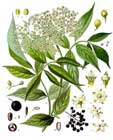 Sambucus nigra. The ELDERBERRY is a deciduous shrub or small tree growing up to 6 metres tall and wide. Yet another very easily grown plant, it tolerates most soils and situations, growing well on chalk and in heavy clay soils. It tolerates some shade but fruits better in a sunny position. It also tolerates atmospheric pollution and coastal situations. The small white flowers are produced in large racemes in late spring and early summer. They make a delicious refreshing snack on a hot day, though you have to be a bit careful when eating them because they are very attractive to a wide range of insects and you could end up eating more than you had bargained for. The flowers can also be used to add a muscatel flavour to stewed fruits, jellies and jams, and are often used to make a sparkling wine.
Sambucus nigra. The ELDERBERRY is a deciduous shrub or small tree growing up to 6 metres tall and wide. Yet another very easily grown plant, it tolerates most soils and situations, growing well on chalk and in heavy clay soils. It tolerates some shade but fruits better in a sunny position. It also tolerates atmospheric pollution and coastal situations. The small white flowers are produced in large racemes in late spring and early summer. They make a delicious refreshing snack on a hot day, though you have to be a bit careful when eating them because they are very attractive to a wide range of insects and you could end up eating more than you had bargained for. The flowers can also be used to add a muscatel flavour to stewed fruits, jellies and jams, and are often used to make a sparkling wine.
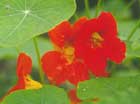 Tropaeolum majus. The only annual plant included in this section, the garden NASTURTIUM tolerates most soils, though it prefers a rich light well-drained soil in full sun or partial shade. More and lusher leaves are produced when the plant is growing in a rich soil, though less flowers are produced. When grown in a soil of low fertility the leaves are smaller and less lush, though more flowers are produced. Plants will often maintain themselves by self-sowing, though in cold springs the seed will often not germinate until mid or even late summer, which is too late to produce a reasonable crop. A very ornamental and free-flowering species, it is often in bloom from early summer until cut down by the autumn frosts. There are many named varieties, ranging from vigorous climbing forms to low-growing dwarf forms. The flowers have a hot, watercress-like flavour and make a tasty addition to the salad bowl. T. minus is a closely related species with the same uses.
Tropaeolum majus. The only annual plant included in this section, the garden NASTURTIUM tolerates most soils, though it prefers a rich light well-drained soil in full sun or partial shade. More and lusher leaves are produced when the plant is growing in a rich soil, though less flowers are produced. When grown in a soil of low fertility the leaves are smaller and less lush, though more flowers are produced. Plants will often maintain themselves by self-sowing, though in cold springs the seed will often not germinate until mid or even late summer, which is too late to produce a reasonable crop. A very ornamental and free-flowering species, it is often in bloom from early summer until cut down by the autumn frosts. There are many named varieties, ranging from vigorous climbing forms to low-growing dwarf forms. The flowers have a hot, watercress-like flavour and make a tasty addition to the salad bowl. T. minus is a closely related species with the same uses.
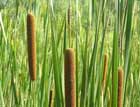 Typha angustifolia. The REEDMACE is a very easily grown plant for boggy pond margins or shallow water up to 15cm deep. It requires a rich soil if it is to do well and succeeds in full sun or part shade. A very invasive plant, it grows 2 metres or more tall and spreads freely at the roots when in a suitable site. It is much too vigorous for growing in small areas and unless restrained by some means, such as a large bottomless container, the plant will soon completely take over a site and will grow into the pond, gradually filling it in. This species will often form an almost complete monoculture in boggy soil. The young flowering stems can be eaten raw, cooked or made into a soup. They have a taste like sweet corn.
Typha angustifolia. The REEDMACE is a very easily grown plant for boggy pond margins or shallow water up to 15cm deep. It requires a rich soil if it is to do well and succeeds in full sun or part shade. A very invasive plant, it grows 2 metres or more tall and spreads freely at the roots when in a suitable site. It is much too vigorous for growing in small areas and unless restrained by some means, such as a large bottomless container, the plant will soon completely take over a site and will grow into the pond, gradually filling it in. This species will often form an almost complete monoculture in boggy soil. The young flowering stems can be eaten raw, cooked or made into a soup. They have a taste like sweet corn.
.jpg) Viola odorata. The SWEET VIOLET succeeds in most soils but prefers a cool moist well-drained humus-rich soil in partial or dappled shade and protection from scorching winds. When grown in an open sunny position it prefers a moderately heavy rich soil. Sweet violets are evergreen perennials growing about 15cm tall and forming spreading clumps. They make an excellent weed-excluding ground cover and will often self-sow when well sited. The delicately scented flowers are produced in late winter and early spring, at which time they are usually the only edible flower available. The flowers are usually deep blue in colour, though there are also white forms. Their sweetly perfumed taste makes them a treat not to be missed. They are also said to be useful as a thickener in soups and stews, and they are used fresh to flavour and colour confectionery. All other members of this genus have more or less edible flowers and are worth trying.
Viola odorata. The SWEET VIOLET succeeds in most soils but prefers a cool moist well-drained humus-rich soil in partial or dappled shade and protection from scorching winds. When grown in an open sunny position it prefers a moderately heavy rich soil. Sweet violets are evergreen perennials growing about 15cm tall and forming spreading clumps. They make an excellent weed-excluding ground cover and will often self-sow when well sited. The delicately scented flowers are produced in late winter and early spring, at which time they are usually the only edible flower available. The flowers are usually deep blue in colour, though there are also white forms. Their sweetly perfumed taste makes them a treat not to be missed. They are also said to be useful as a thickener in soups and stews, and they are used fresh to flavour and colour confectionery. All other members of this genus have more or less edible flowers and are worth trying.
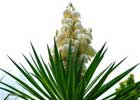 Yucca baccata. There are many hardy species of YUCCA and all of them have more or less edible flowers, though this species is perhaps the best to eat. They thrive in any soil that is very well-drained, but prefer a sandy loam and full exposure to the south. They require a hot dry position if they are to thrive and flower well, once established they are very drought resistant. They are also much hardier when grown on poor sandy soils. There is some disagreement over the hardiness of this species, with some reports saying that it is only hardy in milder areas and another saying that the plants are hardy to at least -30°c. It can be seen doing well in a number of gardens in southern Britain, and it has certainly survived temperatures down to at least -10°c. The white flowers are thick and crunchy with a sweet flavour. It is best to eat them after they have been open for a few days otherwise they can have a soapy flavour.
Yucca baccata. There are many hardy species of YUCCA and all of them have more or less edible flowers, though this species is perhaps the best to eat. They thrive in any soil that is very well-drained, but prefer a sandy loam and full exposure to the south. They require a hot dry position if they are to thrive and flower well, once established they are very drought resistant. They are also much hardier when grown on poor sandy soils. There is some disagreement over the hardiness of this species, with some reports saying that it is only hardy in milder areas and another saying that the plants are hardy to at least -30°c. It can be seen doing well in a number of gardens in southern Britain, and it has certainly survived temperatures down to at least -10°c. The white flowers are thick and crunchy with a sweet flavour. It is best to eat them after they have been open for a few days otherwise they can have a soapy flavour.
Database
The database has more details on these plants: Aquilegia vulgaris, Asclepias tuberosa, Asphodeline lutea, Cercis siliquastrum, Hibiscus syriacus, Malva moschata, Oxalis deppei, Ribes odoratum, Sambucus nigra, Tropaeolum majus, Typha angustifolia, Viola odorata, Yucca baccata.